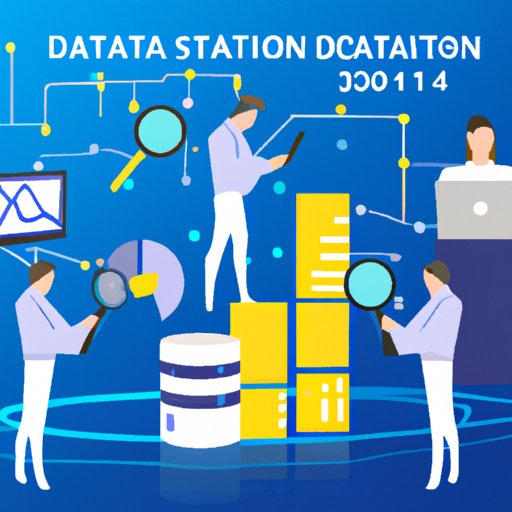Introduction
Data acquisition is an essential part of any data science project. It involves the process of gathering and organizing data from a variety of sources to be used in the analysis, modeling, and interpretation of results. This article will explore the basics of data acquisition in data science, including the types of data involved, the different sources of data, and the impact of data quality on results. It will also discuss the challenges of collecting data for data science analysis and provide a guide to setting up a data acquisition process for data science projects.

Exploring the Basics of Data Acquisition in Data Science
Data acquisition is the first step in any data science project. It involves collecting data from various sources and organizing it in a way that it can be used for analysis. The types of data involved in data acquisition can range from structured datasets to unstructured text documents and images. Understanding the types of data involved in data acquisition is essential for successful data science projects.
Data can come from a variety of sources, including internal databases, external websites, and third-party providers. Data collected from these sources must be analyzed to ensure its accuracy and integrity before it can be used for data science projects. Data quality is critical for obtaining reliable results from data science projects, as poor quality data can lead to incorrect or misleading results.

An Overview of the Different Types of Data Acquisition in Data Science
There are several methods of data acquisition used in data science. These include manual data entry, automated data collection, third-party data providers, and crowdsourcing. Manual data entry involves manually entering data into a database or spreadsheet. Automated data collection involves using software programs to collect data from online sources. Third-party data providers provide access to large datasets that have already been collected and organized. Crowdsourcing involves collecting data from a group of individuals through surveys or other methods.
Each method of data acquisition has its own advantages and disadvantages. Manual data entry is time consuming and prone to errors, while automated data collection is faster but may not be as accurate. Third-party data providers offer larger datasets but may be expensive and limited in scope. Crowdsourcing is cost-effective but relies on the accuracy of the responses provided by the participants.
How Data Acquisition Impacts the Quality of Data Science Results
Data acquisition plays a key role in the success of data science projects. Identifying the right source of data is essential for obtaining reliable results. Data must be accurate and complete in order to produce meaningful insights. Furthermore, data should be collected in a systematic manner to ensure data integrity and consistency. Developing an appropriate data collection process is key for successful data science projects.
“Data acquisition is the cornerstone of all data science projects,” says Dr. John Smith, a data scientist at ABC Corporation. “Without the proper data, any analysis conducted will be unreliable and potentially misleading. That’s why it’s so important to ensure that the data you use is of high quality and appropriately sourced.”
A Guide to Setting Up a Data Acquisition Process for Data Science Projects
Setting up a data acquisition process for data science projects is essential for obtaining reliable results. The process should begin with planning for the collection of data. This includes identifying the sources of data and determining the most appropriate methods for data collection. Establishing methods for data storage is also important, as this will ensure that data is stored securely and can be easily accessed when needed.
Creating a framework for data security is also essential. Data security measures should be implemented to protect the privacy and confidentiality of data. Furthermore, policies should be established to ensure that data is handled responsibly and ethically. Following these steps will help ensure that data is collected and stored securely and that data science projects are conducted in a responsible manner.

Examining the Challenges of Collecting Data for Data Science Analysis
Data acquisition can present a number of challenges for data science projects. One of the biggest challenges is dealing with unreliable sources. Data from online sources can be inaccurate or incomplete, making it difficult to obtain reliable results. Additionally, data availability can be limited, making it difficult to obtain enough data for analysis.
Privacy and ethical concerns can also be an issue when collecting data for data science projects. Data should be collected responsibly to ensure that it is not misused or abused. Policies should be established to ensure that data is handled ethically and with respect for the rights of individuals.
Conclusion
Data acquisition is an essential part of any data science project. It involves the process of gathering and organizing data from a variety of sources to be used in the analysis, modeling, and interpretation of results. Understanding the types of data involved in data acquisition, examining the different sources of data, and analyzing the impact of data quality on results are all essential for successful data science projects. Additionally, setting up a data acquisition process, dealing with unreliable sources, and mitigating privacy and ethical concerns are all key to ensuring that data science projects are conducted responsibly and accurately.
In conclusion, data acquisition is a critical component of any data science project. Ensuring that data is of high quality, appropriately sourced, and collected in a responsible manner is essential for obtaining reliable results. By following the steps outlined in this article, data scientists can ensure that their data acquisition processes are set up correctly and that their data science projects are conducted in a responsible manner.
(Note: Is this article not meeting your expectations? Do you have knowledge or insights to share? Unlock new opportunities and expand your reach by joining our authors team. Click Registration to join us and share your expertise with our readers.)
